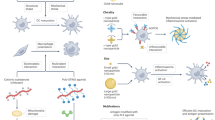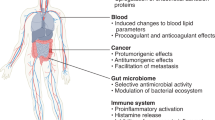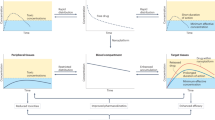Abstract
Most research on the toxicology of nanomaterials has focused on the effects of nanoparticles that enter the body accidentally. There has been much less research on the toxicology of nanoparticles that are used for biomedical applications, such as drug delivery or imaging, in which the nanoparticles are deliberately placed in the body. Moreover, there are no harmonized standards for assessing the toxicity of nanoparticles to the immune system (immunotoxicity). Here we review recent research on immunotoxicity, along with data on a range of nanotechnology-based drugs that are at different stages in the approval process. Research shows that nanoparticles can stimulate and/or suppress the immune responses, and that their compatibility with the immune system is largely determined by their surface chemistry. Modifying these factors can significantly reduce the immunotoxicity of nanoparticles and make them useful platforms for drug delivery.
This is a preview of subscription content, access via your institution
Access options
Subscribe to this journal
Receive 12 print issues and online access
$259.00 per year
only $21.58 per issue
Buy this article
- Purchase on Springer Link
- Instant access to full article PDF
Prices may be subject to local taxes which are calculated during checkout


Similar content being viewed by others
References
Powers, M. Nanomedicine and nano device pipeline surges 68%. NanoBiotech News 1–69 (4 January 2006).
Note for guidance on repeated-dose toxicity (Committee for Proprietary Medicinal Products, London, 2000).
Preclinical Safety Evaluation of Biotechnology — Derived Pharmaceuticals (FDA/CBER/CDER, 1997).
Developing Medical Imaging Drug and Biological Products. Part1: Conducting Safety Assessments (FDA/CBER/CDER, 2004).
Immunotoxicity Studies for Human Pharmaceuticals (FDA/CDER, 2006).
Immunotoxicology Evaluation of Investigational New Drugs (FDA/CDER, 2002).
Immunotoxicity Testing Guidance (FDA/CDRH, 1999).
Leu, D. et al. Distribution and elimination of coated polymethyl [2–14C]methacrylate nanoparticles after intravenous injection in rats. J. Pharm. Sci. 73, 1433–1437 (1984).
Gref, R. et al. Biodegradable long-circulating polymeric nanospheres. Science 263, 1600–1603 (1994).
Goppert, T. M. & Muller, R. H. Polysorbate-stabilized solid lipid nanoparticles as colloidal carriers for intravenous targeting of drugs to the brain: comparison of plasma protein adsorption patterns. J. Drug Target. 13, 179–187 (2005).
McNeil, S. E. Nanotechnology for the biologist. J. Leukoc. Biol. 78, 585–594 (2005).
Standard Terminology Relating to Nanotechnology E 2456-06 (ASTM International, 2006).
Alivisatos, A. P., Gu, W. & Larabell, C. Quantum dots as cellular probes. Annu. Rev. Biomed. Eng. 7, 55–76 (2005).
Bala, I., Hariharan, S. & Kumar, M. N. PLGA nanoparticles in drug delivery: the state of the art. Crit. Rev. Ther. Drug Carrier Syst. 21, 387–422 (2004).
Bulte, J. W. & Kraitchman, D. L. Monitoring cell therapy using iron oxide MR contrast agents. Curr. Pharm. Biotechnol. 5, 567–584 (2004).
Fiorito, S. et al. Toxicity and biocompatibility of carbon nanoparticles. J. Nanosci. Nanotechnol. 6, 591–599 (2006).
Gupta, A. K. & Gupta, M. Cytotoxicity suppression and cellular uptake enhancement of surface modified magnetic nanoparticles. Biomaterials 26, 1565–1573 (2005).
Xu, Y. & Du, Y. Effect of molecular structure of chitosan on protein delivery properties of chitosan nanoparticles. Int. J. Pharm. 250, 215–226 (2003).
Gessner, A., Lieske, A., Paulke, B. & Muller, R. Influence of surface charge density on protein adsorption on polymeric nanoparticles: analysis by two-dimensional electrophoresis. Eur. J. Pharm. Biopharm. 54, 165–170 (2002).
Gessner, A., Lieske, A., Paulke, B. R. & Muller, R. H. Functional groups on polystyrene model nanoparticles: influence on protein adsorption. J. Biomed. Mater. Res. A 65, 319–326 (2003).
Gessner, A. et al. Nanoparticles with decreasing surface hydrophobicities: influence on plasma protein adsorption. Int. J. Pharm. 196, 245–249 (2000).
Luck, M. et al. Plasma protein adsorption on biodegradable microspheres consisting of poly(D,L-lactide-co-glycolide), poly(L-lactide) or ABA triblock copolymers containing poly(oxyethylene). Influence of production method and polymer composition. J. Control. Release 55, 107–120 (1998).
Goppert, T. M. & Muller, R. H. Protein adsorption patterns on poloxamer- and poloxamine-stabilized solid lipid nanoparticles (SLN). Eur. J. Pharm. Biopharm. 60, 361–372 (2005).
Luck, M. et al. Identification of plasma proteins facilitated by enrichment on particulate surfaces: analysis by two-dimensional electrophoresis and N-terminal microsequencing. Electrophoresis 18, 2961–2967 (1997).
Diederichs, J. E. Plasma protein adsorption patterns on liposomes: establishment of analytical procedure. Electrophoresis 17, 607–611 (1996).
Gessner, A., Paulke, B. R., Muller, R. H. & Goppert, T. M. Protein rejecting properties of PEG-grafted nanoparticles: influence of PEG-chain length and surface density evaluated by two-dimensional electrophoresis and bicinchoninic acid (BCA)-proteinassay. Pharmazie 61, 293–297 (2006).
Gref, R. et al. 'Stealth' corona-core nanoparticles surface modified by polyethylene glycol (PEG): influences of the corona (PEG chain length and surface density) and of the core composition on phagocytic uptake and plasma protein adsorption. Colloid. Surf. B 18, 301–313 (2000).
Peracchia, M. T. et al. Visualization of in vitro protein-rejecting properties of PEGylated stealth polycyanoacrylate nanoparticles. Biomaterials 20, 1269–1275 (1999).
Salvador-Morales, C. et al. Complement activation and protein adsorption by carbon nanotubes. Mol. Immunol. 43, 193–201 (2006).
Thode, K. et al. Determination of plasma protein adsorption on magnetic iron oxides: sample preparation. Pharm. Res. 14, 905–910 (1997).
Luck, M. et al. Analysis of plasma protein adsorption on polymeric nanoparticles with different surface characteristics. J. Biomed. Mater. Res. 39, 478–485 (1998).
Balakrishnan, B., Kumar, D. S., Yoshida, Y. & Jayakrishnan, A. Chemical modification of poly(vinyl chloride) resin using poly(ethylene glycol) to improve blood compatibility. Biomaterials 26, 3495–3502 (2005).
Oyewumi, M. O. et al. Comparison of cell uptake, biodistribution and tumor retention of folate-coated and PEG-coated gadolinium nanoparticles in tumor-bearing mice. J. Control. Release 95, 613–626 (2004).
Koziara, J. M. et al. Blood compatibility of cetyl alcohol/polysorbate-based nanoparticles. Pharm. Res. 22, 1821–1828 (2005).
Wang, J. et al. Antioxidative function and biodistribution of [Gd@C82(OH)22]n nanoparticles in tumor-bearing mice. Biochem. Pharmacol. 71, 872–881 (2006).
Chamberlain, P. & Mire-Sluis, A. R. An overview of scientific and regulatory issues for the immunogenicity of biological products. Dev. Biol. 112, 3–11 (2003).
Swanson, S. J., Ferbas, J., Mayeux, P. & Casadevall, N. Evaluation of methods to detect and characterize antibodies against recombinant human erythropoietin. Nephron Clin. Pract. 96, c88–c95 (2004).
Kivisakk, P., Alm, G. V., Fredrikson, S. & Link, H. Neutralizing and binding anti-interferon-beta (IFN-beta) antibodies. A comparison between IFN-beta-1a and IFN-beta-1b treatment in multiple sclerosis. Eur. J. Neurol. 7, 27–34 (2000).
Roberts, J. C., Bhalgat, M. K. & Zera, R. T. Preliminary biological evaluation of polyamidoamine (PAMAM) Starburst dendrimers. J. Biomed. Mater. Res. 30, 53–65 (1996).
Tomii, A. & Masugi, F. Production of anti-platelet-activating factor antibodies by the use of colloidal gold as carrier. Jpn. J. Med. Sci. Biol. 44, 75–80 (1991).
Kreuter, J. Nanoparticles as adjuvants for vaccines. Pharm. Biotechnol. 6, 463–472 (1995).
Chen, B. X. et al. Antigenicity of fullerenes: antibodies specific for fullerenes and their characteristics. Proc. Natl Acad. Sci. USA 95, 10809–10813 (1998).
Braden, B. C. et al. X-ray crystal structure of an anti-Buckminsterfullerene antibody fab fragment: biomolecular recognition of C(60). Proc. Natl. Acad. Sci. U. S. A. 97, 12193–12197 (2000).
Masalova, O. V. et al. Immunostimulating effect of water-soluble fullerene derivatives—perspective adjuvants for a new generation of vaccine. Dokl. Akad. Nauk 369, 411–413 (1999).
Andreev, S. M. et al. Immunogenic and allergenic properties of fulleren conjugates with aminoacids and proteins. Dokl. Biochem. 370, 4–7 (2000).
Stieneker, F., Kreuter, J. & Lower, J. High antibody titres in mice with polymethylmethacrylate nanoparticles as adjuvant for HIV vaccines. AIDS 5, 431–435 (1991).
Castignolles, N. et al. A new family of carriers (biovectors) enhances the immunogenicity of rabies antigens. Vaccine 14, 1353–1360 (1996).
Rajananthanan, P., Attard, G. S., Sheikh, N. A. & Morrow, W. J. Evaluation of novel aggregate structures as adjuvants: composition, toxicity studies and humoral responses. Vaccine 17, 715–730 (1999).
Dykman, L. A. et al. Immunogenic properties of colloidal gold. Izv. Akad. Nauk Biol. 1, 86–91 (2004).
Diwan, M. et al. Biodegradable nanoparticle mediated antigen delivery to human cord blood derived dendritic cells for induction of primary T cell responses. J. Drug Target. 11, 495–507 (2003).
Cui, Z., Han, S. J., Vangasseri, D. P. & Huang, L. Immunostimulation mechanism of LPD nanoparticle as a vaccine carrier. Mol. Pharm. 2, 22–28 (2005).
Xiang, S. D. et al. Pathogen recognition and development of particulate vaccines: does size matter? Methods 40, 1–9 (2006).
Tan, Y., Li, S., Pitt, B. R. & Huang, L. The inhibitory role of CpG immunostimulatory motifs in cationic lipid vector-mediated transgene expression in vivo. Hum. Gene Ther. 10, 2153–2161 (1999).
Dileo, J. et al. Lipid-protamine-DNA-mediated antigen delivery to antigen-presenting cells results in enhanced anti-tumor immune responses. Mol. Ther. 7, 640–648 (2003).
Whitmore, M. M., Li, S., Falo, L. Jr & Huang, L. Systemic administration of LPD prepared with CpG oligonucleotides inhibits the growth of established pulmonary metastases by stimulating innate and acquired antitumor immune responses. Cancer Immunol. Immunother. 50, 503–514 (2001).
Diwan, M., Elamanchili, P., Cao, M. & Samuel, J. Dose sparing of CpG oligodeoxynucleotide vaccine adjuvants by nanoparticle delivery. Curr. Drug Deliv. 1, 405–412 (2004).
Tsao, N. et al. Inhibition of group A streptococcus infection by carboxyfullerene. Antimicrob. Agents Chemother. 45, 1788–1793 (2001).
Shvedova, A. A. et al. Unusual inflammatory and fibrogenic pulmonary responses to single-walled carbon nanotubes in mice. Am. J. Physiol. Lung C. 289, L698–L708 (2005).
Pulskamp, K., Diabate, S. & Krug, H. F. Carbon nanotubes show no sign of acute toxicity but induce intracellular reactive oxygen species in dependence on contaminants. Toxicol. Lett. 168, 58–74 (2007).
Muller, K. et al. Effect of ultrasmall superparamagnetic iron oxide nanoparticles (Ferumoxtran-10) on human monocyte-macrophages in vitro. Biomaterials 28, 1629–1642 (2007).
Shukla, R. et al. Biocompatibility of gold nanoparticles and their endocytotic fate inside the cellular compartment: a microscopic overview. Langmuir 21, 10644–10654 (2005).
van Zijverden, M. & Granum, B. Adjuvant activity of particulate pollutants in different mouse models. Toxicology 152, 69–77 (2000).
Lutsiak, M. E., Kwon, G. S. & Samuel, J. Biodegradable nanoparticle delivery of a Th2-biased peptide for induction of Th1 immune responses. J. Pharm. Pharmacol. 58, 739–747 (2006).
Chong, C. S. et al. Enhancement of T helper type 1 immune responses against hepatitis B virus core antigen by PLGA nanoparticle vaccine delivery. J. Control. Release 102, 85–99 (2005).
Cui, Z. & Mumper, R. J. Coating of cationized protein on engineered nanoparticles results in enhanced immune responses. Int. J. Pharm. 238, 229–239 (2002).
Cui, Z. et al. Strong T cell type-1 immune responses to HIV-1 Tat (1–72) protein-coated nanoparticles. Vaccine 22, 2631–2640 (2004).
de Kozak, Y. et al. Intraocular injection of tamoxifen-loaded nanoparticles: a new treatment of experimental autoimmune uveoretinitis. Eur. J. Immunol. 34, 3702–3712 (2004).
Balenga, N. A. et al. Protective efficiency of dendrosomes as novel nano-sized adjuvants for DNA vaccination against birch pollen allergy. J. Biotechnol. 124, 602–614 (2006).
Rajananthanan, P., Attard, G. S., Sheikh, N. A. & Morrow, W. J. Novel aggregate structure adjuvants modulate lymphocyte proliferation and Th1 and Th2 cytokine profiles in ovalbumin immunized mice. Vaccine 18, 140–152 (1999).
Cui, Z., Hsu, C. H. & Mumper, R. J. Physical characterization and macrophage cell uptake of mannan-coated nanoparticles. Drug Dev. Ind. Pharm. 29, 689–700 (2003).
Blander, J. M. & Medzhitov, R. On regulation of phagosome maturation and antigen presentation. Nat. Immunol. 7, 1029–1035 (2006).
Conner, S. D. & Schmid, S. L. Regulated portals of entry into the cell. Nature 422, 37–44 (2003).
Aderem, A. & Underhill, D. M. Mechanisms of phagocytosis in macrophages. Annu. Rev. Immunol. 17, 593–623 (1999).
Nagayama, S. et al. Fetuin mediates hepatic uptake of negatively charged nanoparticles via scavenger receptor. Int. J. Pharm. 329, 192–198 (2007).
Kim, T. H. et al. Mannosylated chitosan nanoparticle-based cytokine gene therapy suppressed cancer growth in BALB/c mice bearing CT-26 carcinoma cells. Mol. Cancer. Ther. 5, 1723–1732 (2006).
Cuna, M. et al. Development of phosphorylated glucomannan-coated chitosan nanoparticles as nanocarriers for protein delivery. J. Nanosci. Nanotechnol. 6, 2887–2895 (2006).
Vonarbourg, A. et al. Evaluation of pegylated lipid nanocapsules versus complement system activation and macrophage uptake. J. Biomed. Mater. Res. A 78, 620–628 (2006).
von Zur Muhlen, C. et al. Superparamagnetic iron oxide binding and uptake as imaged by magnetic resonance is mediated by the integrin receptor Mac-1 (CD11b/CD18): Implications on imaging of atherosclerotic plaques. Atherosclerosis 193, 101–111 (2007).
Vonarbourg, A., Passirani, C., Saulnier, P. & Benoit, J. P. Parameters influencing the stealthiness of colloidal drug delivery systems. Biomaterials 27, 4356–4373 (2006).
Fang, C. et al. In vivo tumor targeting of tumor necrosis factor-alpha-loaded stealth nanoparticles: effect of MePEG molecular weight and particle size. Eur. J. Pharm. Sci. 27, 27–36 (2006).
Kwon, Y. J., Standley, S. M., Goh, S. L. & Frechet, J. M. Enhanced antigen presentation and immunostimulation of dendritic cells using acid-degradable cationic nanoparticles. J. Control. Release 105, 199–212 (2005).
Champion, J. A. & Mitragotri, S. Role of target geometry in phagocytosis. Proc. Natl Acad. Sci. USA. 103, 4930–4934 (2006).
Shaunak, S. et al. Polyvalent dendrimer glucosamine conjugates prevent scar tissue formation. Nat. Biotechnol. 22, 977–984 (2004).
Cromer, J. R. et al. Functionalized dendrimers as endotoxin sponges. Bioorg. Med. Chem. Lett. 15, 1295–1298 (2005).
Chen, Y. W., Hwang, K. C., Yen, C. C. & Lai, Y. L. Fullerene derivatives protect against oxidative stress in RAW 264.7 cells and ischemia-reperfused lungs. Am. J. Physiol. Reg. I. 287, R21–R26 (2004).
John, A. E. et al. Discovery of a potent nanoparticle P-selectin antagonist with anti-inflammatory effects in allergic airway disease. Faseb J. 17, 2296–2298 (2003).
Dianzani, C. et al. Cholesteryl butyrate solid lipid nanoparticles inhibit adhesion of human neutrophils to endothelial cells. Br. J. Pharmacol. 148, 648–656 (2006).
Higaki, M. et al. Treatment of experimental arthritis with poly(D, L-lactic/glycolic acid) nanoparticles encapsulating betamethasone sodium phosphate. Ann. Rheum. Dis. 64, 1132–1136 (2005).
Sundstrom, J. B. et al. Magnetic resonance imaging of activated proliferating rhesus macaque T cells labeled with superparamagnetic monocrystalline iron oxide nanoparticles. J. Acquir. Immune Defic. Syndr. 35, 9–21 (2004).
Putman, E., van der Laan, J. W. & van Loveren, H. Assessing immunotoxicity: guidelines. Fundam. Clin. Pharmacol. 17, 615–626 (2003).
Putman, E. et al. Assessment of the immunotoxic potential of human pharmaceuticals: a workshop report. Drug Inf. Journal 36, 417–427 (2002).
Snodin, D. J. Regulatory immunotoxicology: does the published evidence support mandatory nonclinical immune function screening in drug development? Regul. Toxicol. Pharmacol. 40, 336–355 (2004).
Haley, P. J. Guidelines on immunotoxicity testing of new chemical entities; consideration of a conundrum. Newsletter of the Society of Toxicology 3–5 (Fall, 2002).
Dean, J. H., Hincks, J. R. & Remandet, B. Immunotoxicology assessment in the pharmaceutical industry. Toxicol. Lett. 102–103, 247–255 (1998).
Patri, A. K., Dobrovolskaia, M. A., Stern, S. T. & McNeil, S. E. in Nanotechnology for Cancer Therapy 105–138 (CRC Press, Boca Raton, 2006).
Sharma, R. et al. Safety profile of ultrasmall superparamagnetic iron oxide ferumoxtran-10: phase II clinical trial data. J. Magn. Reson. Imaging 9, 291–294 (1999).
Enochs, W. S., Harsh, G., Hochberg, F. & Weissleder, R. Improved delineation of human brain tumors on MR images using a long-circulating, superparamagnetic iron oxide agent. J. Magn. Reson. Imaging 9, 228–232 (1999).
Paciotti, G. F. et al. Colloidal gold: a novel nanoparticle vector for tumor directed drug delivery. Drug Deliv. 11, 169–183 (2004).
Unger, E. C. et al. Nanoparticle drug delivery systems The Drug Delivery Companies Report 2001/02 61–63 (2001).
Gao, X. et al. In vivo cancer targeting and imaging with semiconductor quantum dots. Nat. Biotechnol. 22, 969–976 (2004).
Acknowledgements
We thank Nancy Rice, Serguei Kozlov, Banu Zolnik, Jennifer Hall and Anil Patri for helpful discussion and suggestions. We are grateful to Allen Kane for assistance with illustrations. This project has been funded in whole or in part with federal funds from the National Cancer Institute, National Institutes of Health, under contract N01-CO-12400. The content of this publication does not necessarily reflect the views or policies of the Department of Health and Human Services, nor does mention of trade names, commercial products, or organizations imply endorsement by the US Government.
Author information
Authors and Affiliations
Corresponding author
Ethics declarations
Competing interests
The authors declare no competing financial interests.
Rights and permissions
About this article
Cite this article
Dobrovolskaia, M., McNeil, S. Immunological properties of engineered nanomaterials. Nature Nanotech 2, 469–478 (2007). https://doi.org/10.1038/nnano.2007.223
Published:
Issue Date:
DOI: https://doi.org/10.1038/nnano.2007.223
This article is cited by
-
In vivo toxicity and biodistribution of intravenously administered antibiotic-functionalized gold nanoparticles
Gold Bulletin (2024)
-
Nanomaterials: a review of emerging contaminants with potential health or environmental impact
Discover Nano (2023)
-
Mechano-boosting nanomedicine antitumour efficacy by blocking the reticuloendothelial system with stiff nanogels
Nature Communications (2023)
-
Biodistribution and toxicity assessment of methoxyphenyl phosphonium carbosilane dendrimers in 2D and 3D cell cultures of human cancer cells and zebrafish embryos
Scientific Reports (2023)
-
Ceria-vesicle nanohybrid therapeutic for modulation of innate and adaptive immunity in a collagen-induced arthritis model
Nature Nanotechnology (2023)



